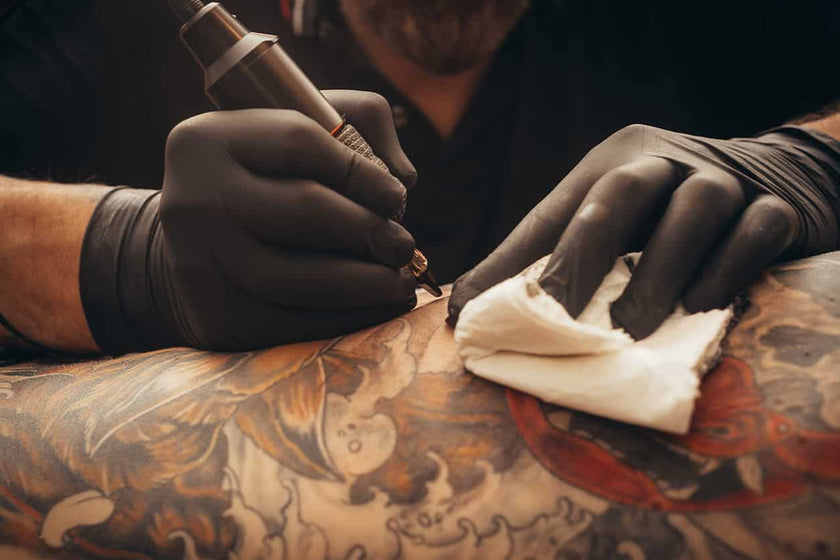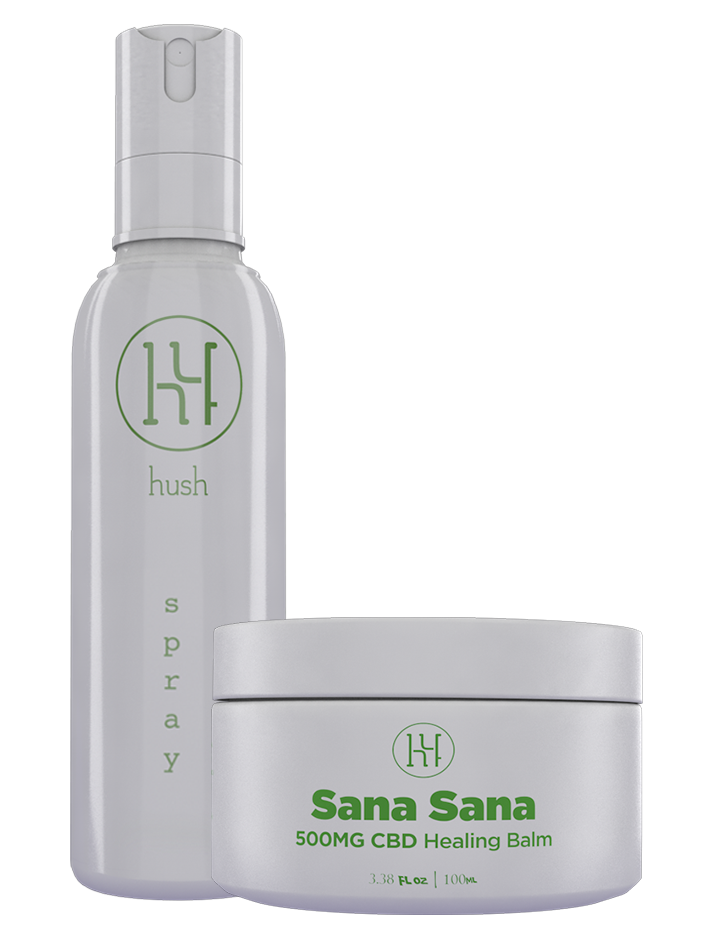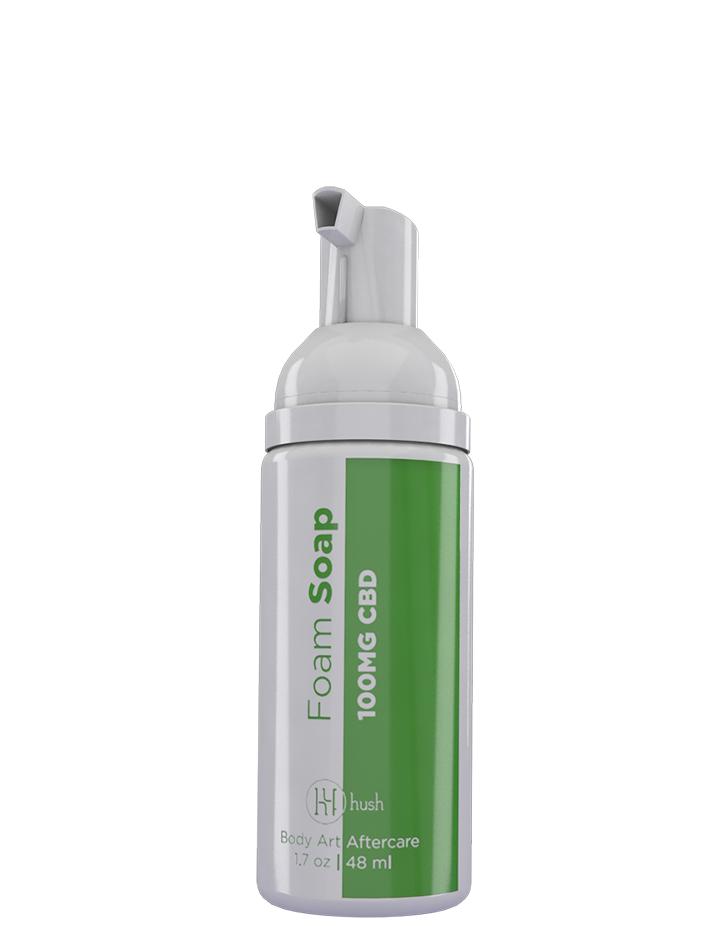
$24.99
The answer is yes! A painless tattoo is no longer a figment of the imagination, thanks to HUSH. HUSH offers a range of products to help you experience a painless tattoo. Our topical anesthetics line makes your skin numb, helping you achieve a painless tattoo.
Most people prefer not to be in pain if they can help it. Tattoos hurt. You see where we’re going with this. Many people would love to have a few great tattoos, but they’re not thrilled with the idea of enduring the pain.
Good news: you don’t have to be in pain to get a tattoo.
You can do plenty of things to reduce tattoo pain and get through your session like a trooper. It all starts with how you prepare for your tattoo appointment.
How Badly Does a Tattoo Hurt?

Pain is a subjective experience. Ask ten people how bad their tattoos hurt, and they’ll give you ten different answers. Some people aren’t particularly bothered by tattoos, especially if they get them in a spot where their body is naturally a little more padded.
Other people will tell horror stories about sitting through a small wrist tattoo. It all depends on the person.
Your Unique Pain Tolerance
Think about a tattoo for what it is. Needles rapidly vibrate several millimeters into your skin to create lines, dots, and shading. You’re going to be punctured countless times. Yes, it’s going to hurt.
You know your pain tolerance. You’re sure of what you can and can’t handle. You're probably worried if you’ve never had a tattoo before, and you know you don’t do well with pain.
If you already know that pain doesn’t phase you much, you may not be. If you’re prepared for your tattoo with HUSH, you’ll hardly feel anything.
Some Spots Hurt Worse Than Others
Think about how it feels when you bump your bicep and compare it to how it feels when you bump your elbow. Body parts with muscle or a thick layer of body fat are well-padded.
Bony parts of your body aren't. If you’re getting a tattoo on a bony or sensitive area of the body, like your hand or your knee, it will have a higher level of pain than a tattoo on your bicep or your forearm.
Is a Painless Tattoo Possible?
A temporary tattoo is completely painless. A permanent tattoo will always involve a little pain, just like anything else we do to improve our look.
It’s also painful to wax your eyebrows or fix an ingrown toenail, but it’s totally worth it. It’s the type of pain that most people can handle.
You can’t eliminate all pain from a tattoo, but you can reduce the pain to a far more tolerable level, similar to the pain of a waxing session. Preparing for your tattoo and choosing a comfortable spot can improve the experience if you know you don’t do well with pain.
How Can I Reduce Tattoo Pain?

We'll let you in on two secrets if you want to know how to reduce tattoo pain. You can pick a less painful spot or prepare the area to prevent you from feeling most of the pain in the first place.
Choose a Different Spot
Switch spots if this is your first tattoo and you plan to put it on a bony part of your body. Flick yourself on your collarbone, and then flick yourself on your bicep. Which hurt worse?
Odds are high that your collarbone really didn’t appreciate it, but your bicep didn’t care that much. If you’re trying to avoid tattoo discomfort, you should use the same strategy. Avoid bony areas like the ribcage, ankles, and armpits, and stick to a part of your body with a little more padding.
If you’re nervous about getting a tattoo, changing the placement to a less painful area might ease your stress. Some of the least painful places to get a tattoo are on the outside of your upper arm, thigh, and booty. Many artists have tattoo pain charts to help you choose a location that promises less pain.
If this is your first tattoo, you might feel better choosing one of these spots because they’re easy to cover with clothing. You don’t have to be “all in” and keep your tattoo out on display, especially if it’s something you’re doing just for yourself.
The tattoo design can also affect how painful your tattoo is. For instance, small tattoos with fine lines typically won’t be as painful as large body art designs that require large swaths of black-out tattoo ink.
The Pre-Tattoo Prep Process
Tattoos are a little bit traumatic to your body. You’re being wounded, but you’re doing it on purpose. Unlike with an accidental injury, you have the time to set yourself up for success before your tattoo but anticipate your body’s needs.
Get plenty of sleep the night before and make sure you stay hydrated. If you’re one of those people that struggles to drink water, try coconut water based electrolyte drinks.
They’ll do a good job of hydrating your body and will also work to keep you hydrated during the healing process. Avoid alcohol for a few days before and after your tattoo to help your body maintain adequate hydration levels while you’re healing up.
Your body burns through blood sugar very quickly during a tattoo. Eat something with protein and whole grains before your session—even if it’s light. Even whole grain toast with some peanut butter is better than going in fasted. In fact, bring some snacks to enjoy mid-session if you think you’ll be there longer than two hours.
Lastly—and the thing that most people don’t think about—be comfortable. Most people in a tattoo studio look really cool, but you’re not expected to follow the same dress code. If you’re more at ease in your slippers and sweatpants, do what works. As long as you’re clothes are clean and you’re cozy, that’s all that matters.
Numb the Area With Lidocaine
Lidocaine can block pain signals, causing you to feel less discomfort when you get a tattoo. It won’t be completely painless, but most people find that over-the-counter lidocaine tattoo prep gels and topical anesthetic creams can significantly reduce the pain they feel during a tattoo.
Most tattoo shops don’t offer numbing cream to people who come in, especially because it increases the waiting period before the tattoo can start. Your artist is on a tight schedule when you're in the shop. They may be unable to wait an hour for the lotion to work before they can get to work.
Numbing creams for tattoos won’t affect the way your tattoo looks or heals. They won’t do anything to disrupt your tattoo artist’s process. Your tattoo artist would likely rather you be comfortable and relaxed throughout your tattoo session.
They want you to be happy and to enjoy your tattoo — not to be ready to run away in a panic or cut the session early. If you use numbing cream and still need to take breaks, that’s okay, too!
Whatever you do, don’t take medications for pain relief before you go into the tattoo parlor. Oral pain relievers like Tylenol, ibuprofen, and aspirin can thin the blood, which can cause a whole host of issues for your tattoo and your artist.
What Is Lidocaine?
Before a doctor, dermatologist, or dentist performs a procedure on you while you’re fully awake, they’ll use lidocaine (or something similar) to prevent you from feeling pain. They’ll usually inject it into the treatment area and allow it to get to work before they begin the procedure.
Lidocaine is an anesthetic agent. It works to block the signals your nerve endings send out, preventing you from feeling pain. It isn’t like a general anesthetic.
You don’t go to sleep or get drowsy. It only works on the nerve endings in the spot where it’s been injected or applied.
It can take lidocaine about 30 minutes to get to work blocking the sensation from nerves. It wears off after a few hours. Lidocaine works differently for different people. For some people, it may only work for about 30 minutes. For others, it can last as long as four hours.
How Does Lidocaine Work for Tattoos?
Lidocaine for tattoos is a topical product, like a cream or a gel. Lidocaine for tattoos isn’t injected into the skin and doesn’t need to be. Tattoo pain is fairly close to the skin's surface because the needle only goes up to two millimeters deep.
The nerve endings affected by a tattoo will have difficulty relaying a pain signal to your brain, which means you won’t feel the full tattoo. It waters down the sensation, making it easier to tolerate a tattoo session for longer.
HUSH Numbing Spray

Anesthetics are introduced to the skin by way of tiny drops or mists. It works immediately upon skin contact, making it a perfect product for keeping a painless tattoo while the artist concentrates on creating a mind-blowing masterpiece!
HUSH Numbing Gel

HUSH numbing gel disperses its numbing qualities to the skin through a jellylike substance and helps keep the skin from developing redness or irritation. It is advisable to apply the gel an hour before the needle touches your skin so it can penetrate deep into the pain receptors of your skin. The numbing can last for about two hours without reapplication if applied correctly!
Which Product Is Best For Painless Tattoo?
Not one product fits all. What may work for one person may not work for the next. Therefore, we suggest asking your tattoo artist or other aficionados which of our products worked best for them.
How Do I Use Numbing Cream To Reduce Tattoo Pain?

Our Tattoo Numbing Cream combines lidocaine's numbing power with aloe vera's soothing power to chill out any skin irritation. Deionized water can help flush out toxins, and marigold flowers' natural cleansing powers help support the healing process.
Ingredients like chamomile and green tea extract work to soothe the skin, and comfrey flower softens the skin. It’s a comprehensive tattoo prep solution.
About an hour before the appointment, you’ll spread a thick layer of Tattoo Numbing Cream over the area where you’re getting your tattoo. If you want to avoid numbing your hands, apply it with gloves or use a popsicle stick to spread it on thick. Cover it with plastic wrap to keep it on and prevent it from transferring to your clothes.
Before your appointment, remove the plastic wrap and wipe away the excess numbing cream. You’re all ready to go. The pain you feel during your tattoo will be mild in comparison to the full sensation of a tattoo. Most tattoo artists limit their sessions to one or two hours at a time, so the numbing cream shouldn’t wear off during the session.
What About Pain While the Tattoo Is Healing?
A tattoo won’t magically feel better as soon as your session ends. Your body still needs to heal. A tattoo might feel similar to a bad sunburn during the healing process.
As it heals, it may also begin to feel very itchy as a side effect of the scabbing. No matter what, though, you can’t scratch your new tattoo.
Our aftercare spray acts as an antiseptic and a numbing agent. It will combat bacteria that can cause infection and soothe the uncomfortable sensations of a healing tattoo. That itchy feeling might drive you crazy. The aftercare spray will kill the itch without the need to scratch.
After a week of healing, the sensation should completely disappear. You won’t need to keep numbing your tattoo. The pain will be totally gone, and you’ll no longer be itchy.
HUSH Has You Covered
Hush’s line of tattoo prep and aftercare products are designed to keep you comfortable and soothe your skin throughout all stages of the tattoo process. Why feel pain when you don’t have to?
Grab a session bundle and take the edge off.
Sources:
Lidocaine (Topical Application Route) Description and Brand Names | Mayo Clinic




